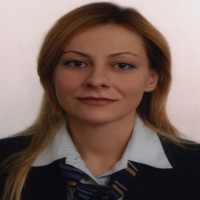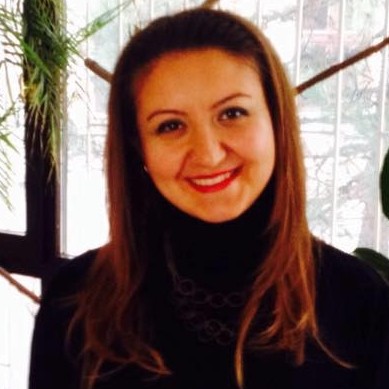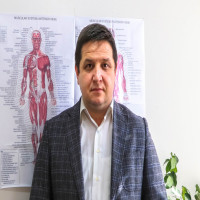Research Articles
Review
Issue Reviewers


 0000-0002-8949-8129
0000-0002-8949-8129
 0000-0002-9040-3940
0000-0002-9040-3940



 0000-0002-3752-7354
0000-0002-3752-7354



 0000-0002-9422-4974
0000-0002-9422-4974

 0000-0002-4410-910X
0000-0002-4410-910X







 0000-0002-7786-8591
0000-0002-7786-8591
Aim & Scope
Gazi Journal of Engineering Sciences (GJES) is an International Refereed Journal published in the field of Engineering (Machinery, Construction, Industry, Computer etc.) and Technology. The objective of GJES is to be able to hear scientific studies both at national and international academic and industrial organizations.
Nowadays, academic publications play an important role in the delivery of technological products and scientific studies to the world of science and industry as a result of interdisciplinary studies.
With this journal, it is aimed to reach the targets of many scientific studies under the concept of engineering. Each original scientific work done in the engineering field is evaluated in our journal.
Before being sent a manuscript to reviewers, it is checked in terms of similarity by iThenticate and similar applications to explore the plagiarism. If the similarity rate is over 20%, the article is directly rejected and returned.GJES has a well -established and international advisory board and serves as Open Access to provide a rapid spread of scientific studies.
Gazi Journal of Engineering Sciences publishes open access articles under a Creative Commons Attribution 4.0 International License (CC BY)

The academic publications sent to GJES are published as open access on the internet three times a year, in April, August and December, after passing through the referee examination.
The publication language of Gazi Journal of Engineering Sciences is Turkish and English.
DOI: 10.30855/gmbd
*** Names of all authors and ORCID ID's should be entered into the system in the first submission phase.
Similarity Report must be uploaded at the first submission stage of the article. (iThenticate / Turnitin - the maximum similarity ratio must be below 20%)
Mechanical Engineering
Metallurgical and Materials Engineering
Civil Engineering
Computer Engineering
Electrical and Electronics Engineering
Industrial Design Engineering
Manufacturing Engineering
Aerospace Engineering
Automotive Engineering
Chemical Engineering
Environmental Engineering
Mining Engineering
Mathematical Applications in Engineering
Other Engineering Fields
Author Guidelines
Gazi Journal of Engineering Sciences, in order to establish scientific communication between scientists working in engineering fields, scientific original articles are accepted in Turkish or English.
Research Article: Studies that reflect original research with findings and results,
Review Article: Compilation an adequate number of scientific articles, summarizing the present knowledge and technology level, evaluating, and comparing these findings by comparing,
Technical Note: Writing a new method or technique describing important findings of a research done.
The Copyright Transfer Form of all manuscripts must be completed by all authors of the manuscript and forwarded to the editor. Publications of authors who do not submit a Copyright Transfer Form are not processed. No additions can be made later by the authors on the articles decided to be published.
Each article is reviewed in form and content by sending at least to two reviewer. The articles determined to be published in the magazine are made ready for publication by making a string of the determined articles.
FIRST PRESENTATION FORMAT
*** Similarity Report must be uploaded during the initial submission of the article.
(iThenticate / Turnitin - maximum similarity rate should be below 20%.)
Articles without similarity report will be returned.
TEXT: It should be written in Times New Roman font, in 12 pt, and should not exceed 20 pages, excluding references and illustrations. Authors should indicate what type of their article is.
TITLE: The title of the work should be written in capital letters, the title should be suitable for the text, short and clear.
The first letters of the first-degree titles in the text should be capitalized and bold. For the second-degree and lower titles, only the first letter of the title should be capitalized and the font thickness should be normal.
ABSTRACT: It should be written in Turkish and English, with a minimum of 150 and a maximum of 200. The title of the work should be written in English at the beginning of the English abstract.
KEYWORDS: Minimum 3 maximum 5 pieces should be given in Turkish/ English.
TEXT: In general, it covers parts related to introduction, method, findings, conclusion and discussion.
REFERENCES
In the brackets [1], [2], etc. Should be numbered with numbers and written at the end of the text according to the order in which they are given in the work.
The IEEE format should be used
Conference Paper in proceedings:
[#] A. Author of Paper and B. Author of Paper, "Title of paper," in Title of Published Proceedings: Proceedings of the Title of Conf.: Subtitle of the conference, Month Date, Year, Location, A. Editor and B. Editor, Eds. Place of publication: Publisher, Year. pp. inclusive page numbers.
[1] L. Liu and H. Miao, "A specification-based approach to testing polymorphic attributes," in Formal Methods and Software Engineering: Proc. of the 6th Int. Conf. on Formal Engineering Methods, ICFEM 2004, Seattle, WA, USA, November 8-12, 2004, J. Davies, W. Schulte, M. Barnett, Eds. Berlin: Springer, 2004. pp. 306-19.
Conference Paper from the internet:
[#] A. Author of Paper and B. Author of Paper, "Title of paper," in Proceedings of the Title of Conf.: Subtitle of the conference, Month Date, Year, Location [Format]. Place of publication: Publisher, Year. Available: Database Name (if appropriate), internet address. [Accessed: date of access].
[2] J. Lach, "SBFS: Steganography based file system," in Proc. of the 2008 1st Int. Conf. on Information Technology, IT 2008, 19-21 May 2008, Gdansk, Poland [Online]. Available: IEEE Xplore, http://www.ieee.org. [Accessed: 10 Sept. 2010].
Journal:
[#] A. A. Author of the article. "Title of article," Title of Journal, vol. #, no. #, pp. page number/s, Month year. Doi: xxx.xxxx
[3] J. R. Beveridge and E. M. Riseman, "How easy is matching 2D line models using a local search?" IEEE Transactions on Pattern Analysis and Machine Intelligence, vol. 19, pp. 564-579, June 1997. Doi: xxx.xxxx
Theses:
[#] A. A. Author, "Title of thesis: Subtitle," Unpublished thesis type, Abbrev, Dept., Abbrev. Univ., Location of University, Abbrev. State, Country, Year.
[4] M. W. Dixon, "Application of neural networks to solve the routing problem in communication networks," Ph.D. dissertation, Murdoch Univ., Murdoch, WA, Australia, 1999.
Book:
Authored; [#] A. Author, Title: Subtitle (in italics), Edition (if not the first), Vol. (if multivolume work). Place of publication: Publisher, Year, page number(s) (if appropriate).
[5] R. Hayes, G. Pisano, D. Upton, and S. Wheelwright, Operations, Strategy, and Technology: Pursuing the competitive edge. Hoboken, NJ: Wiley, 2005.
Edited; [#] A. A. Editor, Title: Subtitle (in italics), Edition (if not the first), Vol. (if multivolume work). Place of publication: Publisher, Year, page number(s) (if appropriate).
[6] D. Sarunyagate, Ed., Lasers. New York: McGraw-Hill, 1996. (Editor)
Internet documents:
[#] A. Author, "Document title," Webpage name, Source/production information, Date of internet publication. [Format]. Available: internet address. [Accessed: Date of access].
[7] J. Geralds, "Sega Ends Production of Dreamcast," vnunet.com, para. 2, Jan. 31, 2001. [Online]. Available: http://nl1.vnunet.com/news/1116995. [Accessed: Sept. 12, 2004].
Charts and figures:
All images without drawings (photographs, drawings, diagrams, graphics, maps, etc.) should be named as shapes. Each chart and figure should be placed where it will be inserted in the text. All forms must be numbered consecutively in the text. Shapes should be no more than 15 cm wide and high resolution.
Formulas and Units:
All formulas in the text should be written in equation format. Formulas should be numbered as (1), (2). All units must be in the SI unit system.
Symbols and Abbreviations:
Text can be given at the end of the source.
Acknowledgement:
If a person or organization is to be acknowledged, it should be written in this section and given before the sources.
Conflict of Interest Statements:
Author / Authors conflict of interest statement should be given in this section before the references.
IF THE ARTICLE IS ACCEPTED AFTER THE REVIEW PROCESS, SHOULD BE LOADED TO THE SYSTEM TO THE LAST PRESENTATION FORMAT.
Ethical Principles and Publication Policy
Copyright and Licensing Policy
Gazi Journal of Engineering Sciences (GJES) publishes open access articles under a Creative Commons Attribution 4.0 International License (CC BY). This license permits user to freely share (copy, distribute and transmit) and adapt the contribution including for commercial purposes, as long as the author is properly attributed.

For all licenses mentioned above, authors can retain copyright and all publication rights without restriction.
Self-Archiving:
Gazi Journal of Engineering Sciences actively supports the author(s) self-archiving process. Journal encourages author(s) to self-archive any version of their manuscript to personal or institutional websites, in repositories and similar, prior to and after the publication of their manuscripts, provided that the author(s) must acknowledge the published source with citation and link the final published article via its Digital Object Identifier (DOI)
PUBLICATION ETHICS & MALPRACTICE STATEMENT
Publication ethics are kept in the course of publication processes in Gazi Journal of Engineering Sciences (e-ISSN 2149-9373) to assure the best practice guidelines and hence it is crucial for the journal’s editors, authors, and peer reviewers to abide by the ethical policies. Gazi Journal of Engineering Sciences conforms to the principles below that are described by COPE’s Code of Conduct and Best Practice Guidelines for Journal Editors (https://publicationethics.org/resources/code-conduct) and not only transparency principles, but also best practice in scholarly publishing pointed out by the Committee on Publication Ethics (COPE).
DUTIES OF EDITOR-IN-CHIEF & SECTION EDITORS
Objectivity:
Editor-in-chief & section editors of the journal are account for deciding which of the manuscripts submitted to the journal ought to be published. In this process, the authors of the manuscript are not distinguished based on his/her race, ethnicity, gender, religion and citizenship by the editors. Editors´ decision to accept, revise or reject a manuscript for publication should be based merely on the importance, originality and clarity of the manuscript, and also convenience of the study performed in manuscript to the coverage of the journal.
Confidentiality:
Editor-in-chief and section editors staff must not reveal any information about a submitted manuscript to anyone but the corresponding author, reviewers/potential reviewers and the publishing personnel. Editors will assure that all material submitted by authors remains confidential during the review process.
Conflicts of interest & Disclosure:
Unpublished materials disclosed in a submitted manuscript must not be utilized in any reviewers’ own studies without express written permission of the author. Exclusive information or opinions attained from peer review process must be maintained confidential and not used for personal benefit. Reviewers ought not to take into account manuscripts in which they have conflicts of interest deriving from competitive, collaborative or other relationships/connections with any of the authors, companies or institutions linked to the articles.
Peer review process:
The editor-in-chief/section editors must assure that a double-blind peer review process is effectively performed for each manuscript submitted to the journal system.
Management of unethical behaviour(s)
Before being sent a manuscript to reviewers, it is checked in terms of similarity by iThenticate and similar applications to explore the plagiarism. If the similarity rate is over 20%, the article is directly rejected and returned.
The editors, together with the publisher(s), should take rationally responsive measures when ethical complaints have been presented regarding a submitted manuscript or published article.
DUTIES OF AUTHOR(S)
Authorship of the paper:
Authorship should be narrowed to those who have made a vital contribution to the reported study including conception, execution, design and interpretation. All authors made significant contributions to the submitted manuscript should be listed as co-authors.
Originality and plagiarism:
The authors are responsible for the content, language and originality of the manuscript they submitted. The authors should assure that they have composed their original works entirely, and if the authors have used the study and/or words of other authors, that this has been conveniently cited or quoted. Plagiarism takes many forms varying from “passing off” someone´s paper as the authors’ own paper to copying or paraphrasing important parts of someone´s paper (without attribution), to claiming results from research performed by others. Plagiarism in all its forms comprises unethical publishing behaviour and is inadmissible. Before being sent a manuscript to reviewers, it is checked in terms of similarity by iThenticate to explore the plagiarism.
Acknowledgement of funding sources:
All funding sources for the research reported in the manuscript should be acknowledged thoroughly at the end of the manuscript before references.
Disclosure and conflicts of interest:
All authors should reveal in their manuscript any financial or other substantive conflicts of interest which may be construed to affect the findings or interpretation of their manuscript. All financial support sources for the project should be disclosed as well. Disclosed examples of potential conflicts of interest include employment, consultancies, stock ownership, honoraria, paid expert testimony, patent applications/registrations, and grants or other funding. Potential conflicts of interest should be declared at the earliest stage possible.
Reporting standards:
Authors of the manuscript should present an accurate explanation of the study conducted and an objective discussion of its importance. Underlying data should be accurately given in the manuscript. A paper should include sufficient detail and references to allow other researchers to repeat the study. Tricky or knowingly imprecise statements form unethical behaviour and are unacceptable. Review and professional publication articles should also be precise, original and objective, and editorial opinion works should be described overtly as such.
Data access & retention:
Authors might be asked to ensure the raw data in connection with a paper for the editorial review process, and should, in any event, be prepared to keep in such data for a moderate time after publication.
Multiple, redundant or concurrent publication:
Submitted manuscripts must not be under consideration of any other journal. Submitting the same manuscript to more than one journal concurrently comprises unethical publishing behaviour. The authors must also assure that the article has not been published elsewhere before.
Principal errors in published studies:
When an author corresponds to a significant error or inaccuracy in his/her own published work, it is the author´s obligation to notify swiftly the journal editor or publisher and cooperate with the editor to withdraw or correct the paper.
DUTIES OF REVIEWERS
Reviewers should review and send the review comments in the due time period. If the manuscript is not in the reviewer’s field of interest, then the manuscript must be sent back to the editor so that the other reviewers can be assigned without losing time.
Contribution:
Reviewers are the main members contributing to the quality of the journal being a peer-reviewed one. The reviewers who feel unqualified to review the received manuscript must swiftly notify the editor and reject to review that manuscript.
Confidentiality:
Any manuscripts received for review must be treated as confidential documents. They must not be shown to or discussed with others except as authorized by the editor.
Objectivity standards:
Reviews should be objectively performed. Personal criticism of the author is unsuitable. Referees should frankly express their aspects with supporting arguments.
Acknowledgement of sources:
Reviewers should describe relating published study which has not been cited by the authors. Any statement that an observation, derivation, or argument had been previously reported should be accompanied by the relevant citation. A reviewer should also point out to the editor’s attention any vital resemblance or coincide between the manuscript under consideration and any other published paper of which they have personal information.
Disclosure & conflict of interest
Reviewers should not take into account the manuscripts in which they have conflicts of interest derived from competitive, collaborative, or other relationships/connections with any of the authors, companies or institutions linked to the manuscripts.
PUBLICATION POLICY
Gazi Journal of Engineering Sciences (GJES) operates the process of publishing scientific articles as an international refereed journal and continues its publishing life in line with the following principles.
1. GJES is published three (3) times a year (April, August and December).
2. GJES is published only electronically.
3. GJES includes articles produced in the fields of Engineering (Machinery, Construction, Industry, Computers etc.) and Technology.
4. Articles submitted to the journal are accepted in Turkish or English.
5. The review and evaluation process of the submitted articles is carried out by “Blind Peer Review” method (by preventing the reviewers and authors from seeing each other's information).
6. GJES adopts Open Source Publishing Policy.
7. In our journal, there is no charge for publishing articles and accessing published articles. Authors and referees are not paid for articles accepted for publication.
8. In our journal, the article evaluation process is expected to take a maximum of 6 months for each article depending on the reviewer evaluations.
9. Before being sent a manuscript to reviewers, it is checked in terms of similarity by iThenticate and similar applications to explore the plagiarism. If the similarity rate is over 20%, the article is directly rejected and returned.
10. When the “Correction” decision is taken for the submitted articles, the authors should make the necessary corrections within 15 days and upload the final version of the article to the system. Editors have the right to reject the article if the corrections are made within the specified time.
11. Articles submitted to the journal should not be published elsewhere or submitted for publication
12. For the studies that were used as theses, presentations or papers and sent to our journal as an article, the information regarding the previous use should be given as footnotes on the first page according to the following conditions:
If the study was published as a summary report; the title of the report, name of the event, date and place information should be written.
If the study was produced from postgraduate theses; The name of the thesis, the name of the consultant, the university and institute at which it was made, and the date of completion and location information should be written.
If the study was supported by the research institution or fund; The name of the organization providing the support, project number and date of completion should be written.
Activity information should be written in a distinctive way for articles produced from published and partly published works outside the specified conditions.
13. Before the submitted articles are submitted to the referees, the following points are examined and the articles found suitable for the evaluation process are sent to the reviewers:
Compliance with spelling rules,
Formally fit the template,
Compliance with its aim and scope,
Compliance with publication principles,
Compliance with publication ethics,
Scientific quality and originality.
14. An article is evaluated by at least 2 reviewers and it should be deemed suitable to be published by at least 2 reviewers a prerequisite for being accepted for publication. After the approval of the reviewers, the Editor-in-Chief and Editorial Board have the power to decide whether the article will be published or not.
15. All authors who submit articles to our journal have equal rights. No privileges are given to the author or the author during the evaluation, acceptance and publishing processes of the articles. The publishing order of the accepted articles is adjusted according to the acceptance time. However, the Editorial Board reserves the right to make changes when it deems necessary.
16. After an article is accepted for publication, “Copyright Transfer Form” must be filled in and signed by all authors and uploaded to the journal system.
17. Articles accepted for publication are published by Gazi Journal of Engineering Sciences (GJES) with full publication rights.
18. Articles submitted to our journal are subject to plagiarism control processes (iThenticate etc.). If the plagiarism detected before the publication exceeds 20%, the article is rejected before the referee evaluation process is started. Unpublished is applied for plagiarism detected after publication and an editorial note is published in the journal for readers.
Price Policy
Gazi Journal of Engineering Sciences (GJES) does not charge any fee from authors for publishing and accessing published articles.

